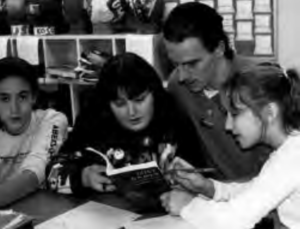 I first was introduced to the novel Lost Names during a recent postgraduate fellowship I participated in entitled Imperial Japan— Expansion and War, 1892 to 1945. Sponsored by the Five College Center for East Asian Studies, the seminar was conducted at Mount Holyoke College. Our preconference assignment included reading this novel, and we actually had the opportunity to meet its author, Richard E. Kim, during the conference. He helped us analyze our feelings and reactions to his powerful story. In announcing its reprinting, scheduled for 1998, he previewed our group with his own Author’s Note for this new edition in which he states that he is proud of the fact that his work is often taken as a factual memoir, not fiction.
I first was introduced to the novel Lost Names during a recent postgraduate fellowship I participated in entitled Imperial Japan— Expansion and War, 1892 to 1945. Sponsored by the Five College Center for East Asian Studies, the seminar was conducted at Mount Holyoke College. Our preconference assignment included reading this novel, and we actually had the opportunity to meet its author, Richard E. Kim, during the conference. He helped us analyze our feelings and reactions to his powerful story. In announcing its reprinting, scheduled for 1998, he previewed our group with his own Author’s Note for this new edition in which he states that he is proud of the fact that his work is often taken as a factual memoir, not fiction.
Fast-forward one year, and I am now teaching Seventh Grade Social Studies at the Brimmer and May School in Chestnut Hill, Massachusetts. Brimmer is a small, coed private school and a member of the Coalition of Essential Schools. The philosophy of this coalition promotes a collaborative education encompassing the values of independent thinking with group oriented problem solving and analytical skills, community, individual responsibility, citizenship, and respect.
In this collaborative setting, I found myself team teaching these students with Joseph Iuliano, who taught English in addition to being Head of the Middle School. Interestingly enough, when we met over the summer, we were both new teachers to the Brimmer community. Our initial course curriculum goal was to meld writing skills with the study of geography and culture of the Middle East, Africa, and Latin America. We also planned to incorporate a student project entitled “Family History—A Short Story.” Questions to be addressed included: what resources can students use to learn about their ancestors and other cultures; and how can factual events be used to enhance a fictional work? For this project, we required both accurate historical and cultural information, along with a solid narrative model, which the students could relate to and emulate. We also wanted to ensure that this experience would be academically enriching for them as well as being personally satisfying.
In August, I had given Joe my copy of Lost Names as potential curriculum material for his English class. He rediscovered the book while cleaning out his office prior to this term and began reading it. Simultaneously, I realized that we were doing the students a disservice in not studying the cultures of Asia. In discussing this lapse with him, we realized that this novel would be a perfect fit for our project. When both Joe and myself had initially read Lost Names, we did so without realizing that it was a work of fiction because of its personal intensity. We hoped that our students would assume the same until they read the Author’s Note at the end, thus subliminally impressing upon them the literary style we were looking for.

In addition to reading the book to appreciate its composition, we also wanted our students to glean the significance of the actual history. Lost Names contains pronounced anti-Japanese sentiment expressed from the black vs. white/good vs. bad viewpoint of a young boy. In order to counterbalance this one-sided view, I also chose to incorporate excerpts from other works such as Saburo Ienaga’s The Pacific War: 1931–1945, Norma Field’s In the Realm of a Dying Emperor, and films like Isao Takahata’s Grave of the Fireflies, which all added critical insight into this study. My fear was that if I presented Lost Names on its own, my students would walk away with a biased opinion of Japan instead of a variety of perspectives from which they could judge Japanese culture and political actions themselves. We did not believe our seventh grade students had been exposed to a strong enough background in World War II history to prevent a bias if the book was taken on its own.
Some initial student comments regarding Lost Names follow:
We learned a lot about war and life in it. After we read the book we watched a video about life in Japan during the war. I found out that life was no picnic there either.
Lost Names was a really moving story. I think Lost Names was the perfect book to read before we did the Family History Short Story Project.
. . . it was a great example of an autobiography and dealing with hardships. Lost Names is a lot easier to understand than many other World War II references. It is also rare to find a book with a Korean point of view.
I am the same age as the narrator, but we have some huge differences in our lifestyles. I can play football and use computers and do a lot of different things. He was forced to work on building an airfield.
Before reading Lost Names, I always had thought of books based on history as being boring, but after finishing it and writing the short story on my family history, I realized what I had thought wasn’t necessarily true.
My great grandfather, the person I am writing about, also suffered through a lot of persecution because he was Jewish. Reading about this boy’s experiences helped me to understand what might have happened to my great grandfather.
The real events in Lost Names make it a great research tool as well as a great book that teaches different writing styles.
Many of the students’ projects on family history coincidentally involve that same period of time illustrated in Lost Names. I think this novel gave them an added perspective on the political changes erupting at this time. The novel also illustrated to them that persecution and political unrest exists across all cultures and age groups. They not only learned what factors affected their recent ancestors’ choices in life, but that these factors are in a way universal.
Lost Names is a multidisciplinary novel; it goes beyond the confines of social studies or a history course; I plan to incorporate it into my United States History courses in the future. I hope my seventh graders will have the opportunity to study Lost Names at some other time in their educational career with an insight gained from their Family History Short Story Projects.

